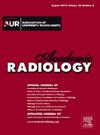Radiomics Combined with ACR TI-RADS for Thyroid Nodules: Diagnostic Performance, Unnecessary Biopsy Rate, and Nomogram Construction
IF 3.8
2区 医学
Q1 RADIOLOGY, NUCLEAR MEDICINE & MEDICAL IMAGING
引用次数: 0
Abstract
Rationale and Objectives
To develop a radiomics model with enhanced diagnostic performance, reduced unnecessary fine needle aspiration biopsy (FNA) rate, and improved clinical net benefit for thyroid nodules.
Methods
We conducted a retrospective study of 217 thyroid nodules. Lesions were divided into training (n = 152) and verification (n = 65) cohorts. Three radiomics scores were derived from B-mode ultrasound (B-US) and strain elastography (SE) images, alone and in combination. A radiomics nomogram was constructed by combining high-frequency ultrasonic features and the best-performing radiomics score. The area under the receiver operating characteristic curve (AUC), unnecessary FNA rate, and decision curve analysis (DCA) results for the nomogram were compared to those obtained with the American College of Radiology Thyroid Imaging, Reporting and Data System (ACR TI-RADS) score and the combined TI-RADS + SE + contrast-enhanced ultrasound (CEUS) advanced clinical score.
Results
The three radiomics scores (B-US, SE, B-US + SE) achieved training AUCs of 0.753 (0.668–0.825), 0.761 (0.674–0.838), and 0.795 (0.715–0.871), and validation AUCs of 0.732 (0.579–0.867), 0.753 (0.609–0.892), and 0.752 (0.592–0.899) respectively. The AUC of the nomogram for the entire patient cohort was 0.909 (0.864–0.954), which was higher than that of the ACR TI-RADS score (P < 0.001) and equivalent to the TI-RADS+SE+CEUS score (P = 0.753). Similarly, the unnecessary FNA rate of the radiomics nomogram was significantly lower than that of the ACR TI-RADS score (P = 0.007) and equivalent to the TI-RADS+SE+CEUS score (P = 0.457). DCA also showed that the radiomics nomogram brought more net clinical benefit than the ACR TI-RADS score but was similar to that of the TI-RADS + SE + CEUS score.
Conclusion
The radiomics nomogram developed in this study can be used as an objective, accurate, cost-effective, and noninvasive method for the characterization of thyroid nodules.
结合 ACR TI-RADS 的甲状腺结节放射组学:诊断性能、不必要的活检率和示意图构建。
理论依据和目标:开发一种放射组学模型,提高诊断性能,减少不必要的细针穿刺活检(FNA)率,提高甲状腺结节的临床净效益:我们对 217 例甲状腺结节进行了回顾性研究。病变分为训练组(152 例)和验证组(65 例)。从 B 型超声(B-US)和应变弹性成像(SE)图像中得出三个放射组学评分,包括单独评分和组合评分。结合高频超声波特征和表现最佳的放射组学评分,构建了放射组学提名图。将提名图的接收者操作特征曲线下面积(AUC)、不必要的 FNA 率和决策曲线分析(DCA)结果与美国放射学会甲状腺成像、报告和数据系统(ACR TI-RADS)评分和 TI-RADS+SE+ 造影剂增强超声(CEUS)联合高级临床评分进行了比较:三种放射组学评分(B-US、SE、B-US+SE)的训练AUC分别为0.753(0.668-0.825)、0.761(0.674-0.838)和0.795(0.715-0.871),验证AUC分别为0.732(0.579-0.867)、0.753(0.609-0.892)和0.752(0.592-0.899)。整个患者队列的提名图的AUC为0.909(0.864-0.954),高于ACR TI-RADS评分(P 结论:本研究开发的放射组学提名图的AUC为0.909(0.864-0.954),高于ACR TI-RADS评分:本研究开发的放射组学提名图可作为一种客观、准确、经济、无创的甲状腺结节特征描述方法。
本文章由计算机程序翻译,如有差异,请以英文原文为准。
求助全文
约1分钟内获得全文
求助全文
来源期刊

Academic Radiology
医学-核医学
CiteScore
7.60
自引率
10.40%
发文量
432
审稿时长
18 days
期刊介绍:
Academic Radiology publishes original reports of clinical and laboratory investigations in diagnostic imaging, the diagnostic use of radioactive isotopes, computed tomography, positron emission tomography, magnetic resonance imaging, ultrasound, digital subtraction angiography, image-guided interventions and related techniques. It also includes brief technical reports describing original observations, techniques, and instrumental developments; state-of-the-art reports on clinical issues, new technology and other topics of current medical importance; meta-analyses; scientific studies and opinions on radiologic education; and letters to the Editor.
 求助内容:
求助内容: 应助结果提醒方式:
应助结果提醒方式:


